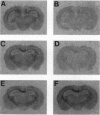Abstract
The main physiological regulator of erythropoiesis is the hematopoietic growth factor erythropoietin (EPO), which is induced in response to hypoxia. Binding of EPO to the EPO receptor (EPO-R), a member of the cytokine receptor superfamily, controls the terminal maturation of red blood cells. So far, EPO has been reported to act mainly on erythroid precursor cells. However, we have detected mRNA encoding both EPO and EPO-R in mouse brain by reverse transcription-PCR. Exposure to 0.1% carbon monoxide, a procedure that causes functional anemia, resulted in a 20-fold increase of EPO mRNA in mouse brain as quantified by competitive reverse transcription-PCR, whereas the EPO-R mRNA level was not influenced by hypoxia. Binding studies on mouse brain sections revealed defined binding sites for radioiodinated EPO in distinct brain areas. The specificity of EPO binding was assessed by homologous competition with an excess of unlabeled EPO and by using two monoclonal antibodies against human EPO, one inhibitory and the other noninhibitory for binding of EPO to EPO-R. Major EPO binding sites were observed in the hippocampus, capsula interna, cortex, and midbrain areas. Functional expression of the EPO-R and hypoxic upregulation of EPO suggest a role of EPO in the brain.
Full text
PDF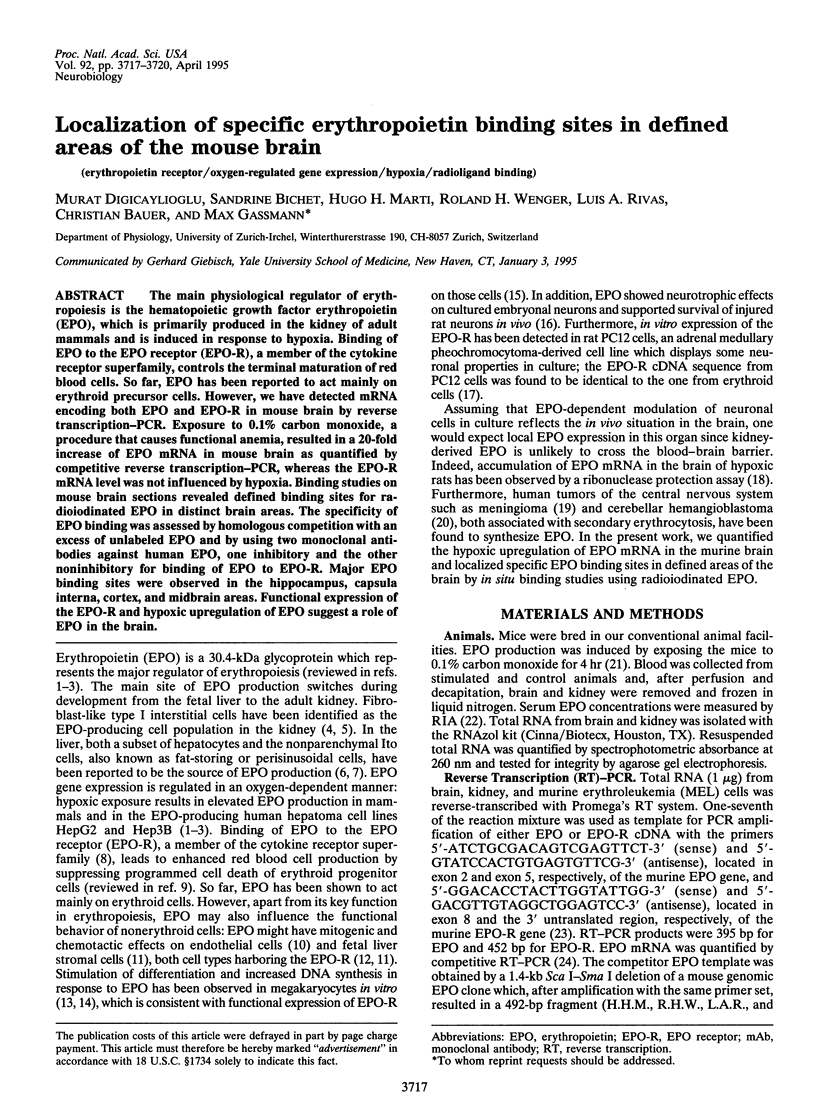
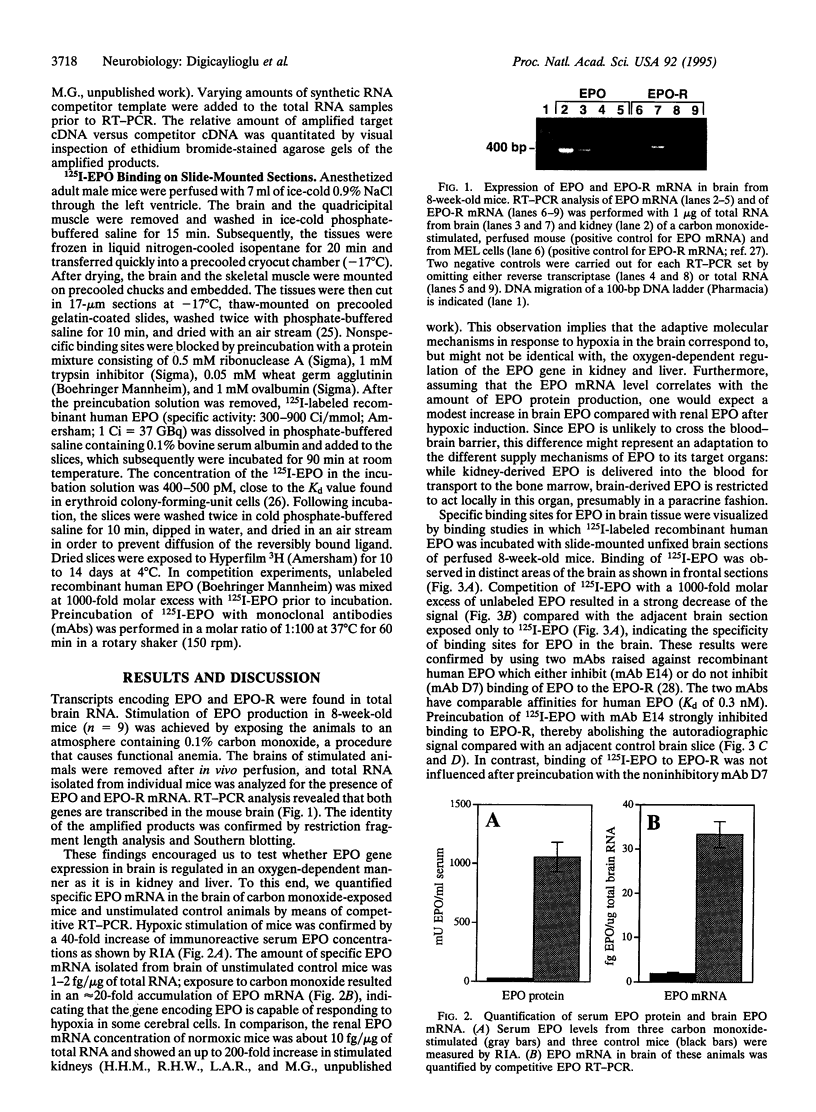
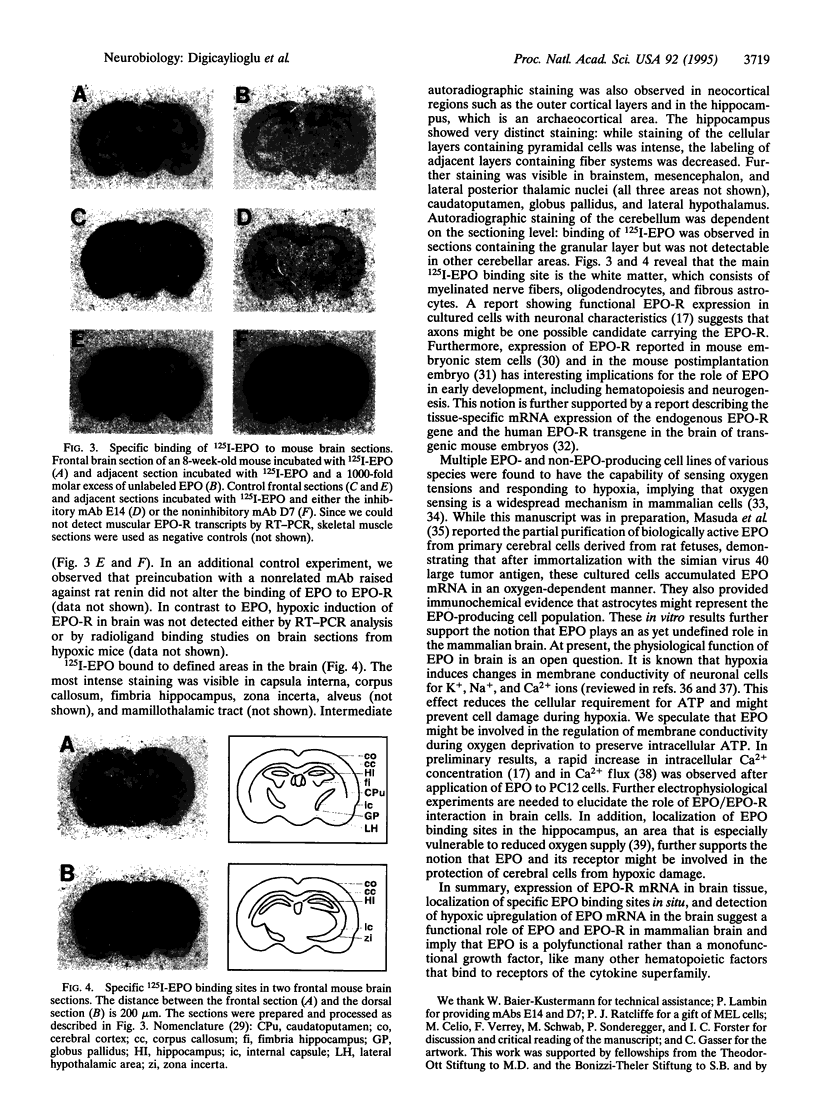
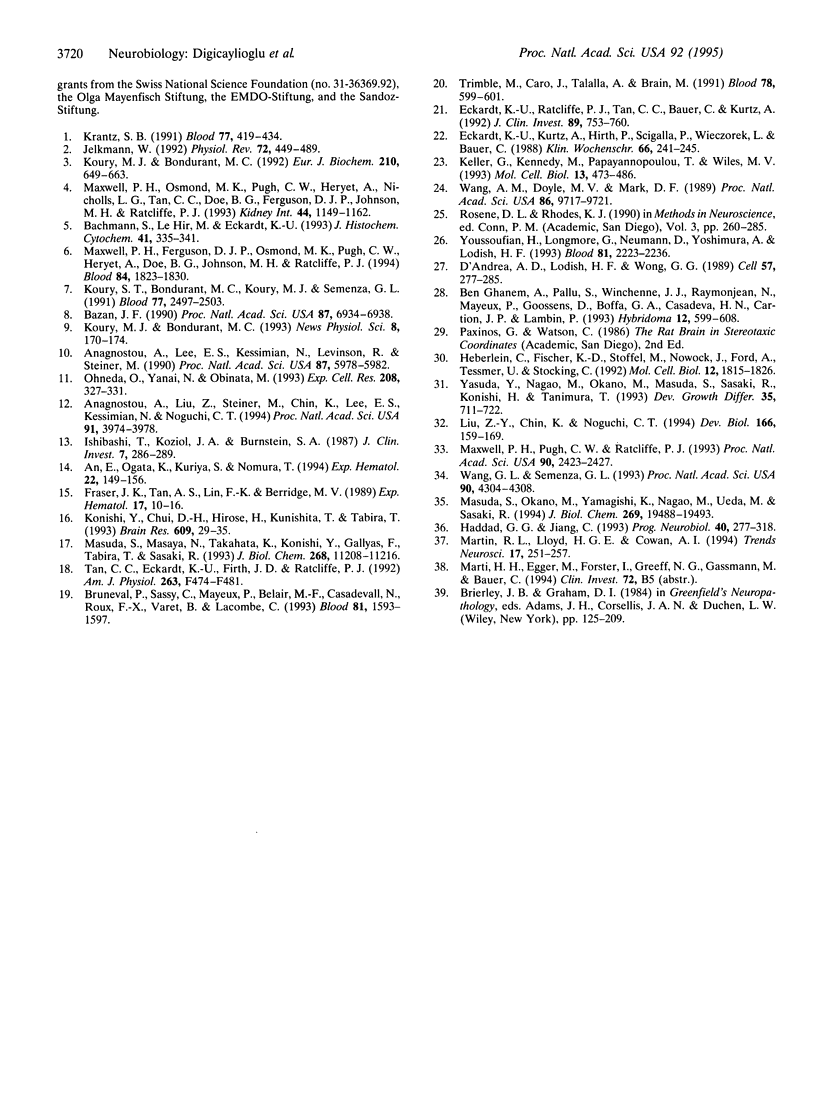
Images in this article
Selected References
These references are in PubMed. This may not be the complete list of references from this article.
- An E., Ogata K., Kuriya S., Nomura T. Interleukin-6 and erythropoietin act as direct potentiators and inducers of in vitro cytoplasmic process formation on purified mouse megakaryocytes. Exp Hematol. 1994 Feb;22(2):149–156. [PubMed] [Google Scholar]
- Anagnostou A., Lee E. S., Kessimian N., Levinson R., Steiner M. Erythropoietin has a mitogenic and positive chemotactic effect on endothelial cells. Proc Natl Acad Sci U S A. 1990 Aug;87(15):5978–5982. doi: 10.1073/pnas.87.15.5978. [DOI] [PMC free article] [PubMed] [Google Scholar]
- Anagnostou A., Liu Z., Steiner M., Chin K., Lee E. S., Kessimian N., Noguchi C. T. Erythropoietin receptor mRNA expression in human endothelial cells. Proc Natl Acad Sci U S A. 1994 Apr 26;91(9):3974–3978. doi: 10.1073/pnas.91.9.3974. [DOI] [PMC free article] [PubMed] [Google Scholar]
- Bachmann S., Le Hir M., Eckardt K. U. Co-localization of erythropoietin mRNA and ecto-5'-nucleotidase immunoreactivity in peritubular cells of rat renal cortex indicates that fibroblasts produce erythropoietin. J Histochem Cytochem. 1993 Mar;41(3):335–341. doi: 10.1177/41.3.8429197. [DOI] [PubMed] [Google Scholar]
- Bazan J. F. Structural design and molecular evolution of a cytokine receptor superfamily. Proc Natl Acad Sci U S A. 1990 Sep;87(18):6934–6938. doi: 10.1073/pnas.87.18.6934. [DOI] [PMC free article] [PubMed] [Google Scholar]
- Ben Ghanem A., Pallu S., Winchenne J. J., Raymonjean N., Mayeux P., Goossens D., Boffa G. A., Casadevall N., Cartron J. P., Lambin P. Preparation and biological properties of monoclonal antibodies against human erythropoietin. Hybridoma. 1993 Oct;12(5):599–608. doi: 10.1089/hyb.1993.12.599. [DOI] [PubMed] [Google Scholar]
- Bruneval P., Sassy C., Mayeux P., Belair M. F., Casadevall N., Roux F. X., Varet B., Lacombe C. Erythropoietin synthesis by tumor cells in a case of meningioma associated with erythrocytosis. Blood. 1993 Mar 15;81(6):1593–1597. [PubMed] [Google Scholar]
- D'Andrea A. D., Lodish H. F., Wong G. G. Expression cloning of the murine erythropoietin receptor. Cell. 1989 Apr 21;57(2):277–285. doi: 10.1016/0092-8674(89)90965-3. [DOI] [PubMed] [Google Scholar]
- Eckardt K. U., Kurtz A., Hirth P., Scigalla P., Wieczorek L., Bauer C. Evaluation of the stability of human erythropoietin in samples for radioimmunoassay. Klin Wochenschr. 1988 Mar 15;66(6):241–245. doi: 10.1007/BF01748163. [DOI] [PubMed] [Google Scholar]
- Eckardt K. U., Ratcliffe P. J., Tan C. C., Bauer C., Kurtz A. Age-dependent expression of the erythropoietin gene in rat liver and kidneys. J Clin Invest. 1992 Mar;89(3):753–760. doi: 10.1172/JCI115652. [DOI] [PMC free article] [PubMed] [Google Scholar]
- Fraser J. K., Tan A. S., Lin F. K., Berridge M. V. Expression of specific high-affinity binding sites for erythropoietin on rat and mouse megakaryocytes. Exp Hematol. 1989 Jan;17(1):10–16. [PubMed] [Google Scholar]
- Haddad G. G., Jiang C. O2 deprivation in the central nervous system: on mechanisms of neuronal response, differential sensitivity and injury. Prog Neurobiol. 1993 Mar;40(3):277–318. doi: 10.1016/0301-0082(93)90014-j. [DOI] [PubMed] [Google Scholar]
- Heberlein C., Fischer K. D., Stoffel M., Nowock J., Ford A., Tessmer U., Stocking C. The gene for erythropoietin receptor is expressed in multipotential hematopoietic and embryonal stem cells: evidence for differentiation stage-specific regulation. Mol Cell Biol. 1992 Apr;12(4):1815–1826. doi: 10.1128/mcb.12.4.1815. [DOI] [PMC free article] [PubMed] [Google Scholar]
- Ishibashi T., Koziol J. A., Burstein S. A. Human recombinant erythropoietin promotes differentiation of murine megakaryocytes in vitro. J Clin Invest. 1987 Jan;79(1):286–289. doi: 10.1172/JCI112796. [DOI] [PMC free article] [PubMed] [Google Scholar]
- Jelkmann W. Erythropoietin: structure, control of production, and function. Physiol Rev. 1992 Apr;72(2):449–489. doi: 10.1152/physrev.1992.72.2.449. [DOI] [PubMed] [Google Scholar]
- Keller G., Kennedy M., Papayannopoulou T., Wiles M. V. Hematopoietic commitment during embryonic stem cell differentiation in culture. Mol Cell Biol. 1993 Jan;13(1):473–486. doi: 10.1128/mcb.13.1.473. [DOI] [PMC free article] [PubMed] [Google Scholar]
- Konishi Y., Chui D. H., Hirose H., Kunishita T., Tabira T. Trophic effect of erythropoietin and other hematopoietic factors on central cholinergic neurons in vitro and in vivo. Brain Res. 1993 Apr 23;609(1-2):29–35. doi: 10.1016/0006-8993(93)90850-m. [DOI] [PubMed] [Google Scholar]
- Koury M. J., Bondurant M. C. The molecular mechanism of erythropoietin action. Eur J Biochem. 1992 Dec 15;210(3):649–663. doi: 10.1111/j.1432-1033.1992.tb17466.x. [DOI] [PubMed] [Google Scholar]
- Koury S. T., Bondurant M. C., Koury M. J., Semenza G. L. Localization of cells producing erythropoietin in murine liver by in situ hybridization. Blood. 1991 Jun 1;77(11):2497–2503. [PubMed] [Google Scholar]
- Krantz S. B. Erythropoietin. Blood. 1991 Feb 1;77(3):419–434. [PubMed] [Google Scholar]
- Liu Z. Y., Chin K., Noguchi C. T. Tissue specific expression of human erythropoietin receptor in transgenic mice. Dev Biol. 1994 Nov;166(1):159–169. doi: 10.1006/dbio.1994.1304. [DOI] [PubMed] [Google Scholar]
- Martin R. L., Lloyd H. G., Cowan A. I. The early events of oxygen and glucose deprivation: setting the scene for neuronal death? Trends Neurosci. 1994 Jun;17(6):251–257. doi: 10.1016/0166-2236(94)90008-6. [DOI] [PubMed] [Google Scholar]
- Masuda S., Nagao M., Takahata K., Konishi Y., Gallyas F., Jr, Tabira T., Sasaki R. Functional erythropoietin receptor of the cells with neural characteristics. Comparison with receptor properties of erythroid cells. J Biol Chem. 1993 May 25;268(15):11208–11216. [PubMed] [Google Scholar]
- Masuda S., Okano M., Yamagishi K., Nagao M., Ueda M., Sasaki R. A novel site of erythropoietin production. Oxygen-dependent production in cultured rat astrocytes. J Biol Chem. 1994 Jul 29;269(30):19488–19493. [PubMed] [Google Scholar]
- Maxwell P. H., Ferguson D. J., Osmond M. K., Pugh C. W., Heryet A., Doe B. G., Johnson M. H., Ratcliffe P. J. Expression of a homologously recombined erythopoietin-SV40 T antigen fusion gene in mouse liver: evidence for erythropoietin production by Ito cells. Blood. 1994 Sep 15;84(6):1823–1830. [PubMed] [Google Scholar]
- Maxwell P. H., Osmond M. K., Pugh C. W., Heryet A., Nicholls L. G., Tan C. C., Doe B. G., Ferguson D. J., Johnson M. H., Ratcliffe P. J. Identification of the renal erythropoietin-producing cells using transgenic mice. Kidney Int. 1993 Nov;44(5):1149–1162. doi: 10.1038/ki.1993.362. [DOI] [PubMed] [Google Scholar]
- Maxwell P. H., Pugh C. W., Ratcliffe P. J. Inducible operation of the erythropoietin 3' enhancer in multiple cell lines: evidence for a widespread oxygen-sensing mechanism. Proc Natl Acad Sci U S A. 1993 Mar 15;90(6):2423–2427. doi: 10.1073/pnas.90.6.2423. [DOI] [PMC free article] [PubMed] [Google Scholar]
- Ohneda O., Yanai N., Obinata M. Erythropoietin as a mitogen for fetal liver stromal cells which support erythropoiesis. Exp Cell Res. 1993 Sep;208(1):327–331. doi: 10.1006/excr.1993.1253. [DOI] [PubMed] [Google Scholar]
- Tan C. C., Eckardt K. U., Firth J. D., Ratcliffe P. J. Feedback modulation of renal and hepatic erythropoietin mRNA in response to graded anemia and hypoxia. Am J Physiol. 1992 Sep;263(3 Pt 2):F474–F481. doi: 10.1152/ajprenal.1992.263.3.F474. [DOI] [PubMed] [Google Scholar]
- Trimble M., Caro J., Talalla A., Brain M. Secondary erythrocytosis due to a cerebellar hemangioblastoma: demonstration of erythropoietin mRNA in the tumor. Blood. 1991 Aug 1;78(3):599–601. [PubMed] [Google Scholar]
- Wang A. M., Doyle M. V., Mark D. F. Quantitation of mRNA by the polymerase chain reaction. Proc Natl Acad Sci U S A. 1989 Dec;86(24):9717–9721. doi: 10.1073/pnas.86.24.9717. [DOI] [PMC free article] [PubMed] [Google Scholar]
- Wang G. L., Semenza G. L. General involvement of hypoxia-inducible factor 1 in transcriptional response to hypoxia. Proc Natl Acad Sci U S A. 1993 May 1;90(9):4304–4308. doi: 10.1073/pnas.90.9.4304. [DOI] [PMC free article] [PubMed] [Google Scholar]
- Youssoufian H., Longmore G., Neumann D., Yoshimura A., Lodish H. F. Structure, function, and activation of the erythropoietin receptor. Blood. 1993 May 1;81(9):2223–2236. [PubMed] [Google Scholar]





